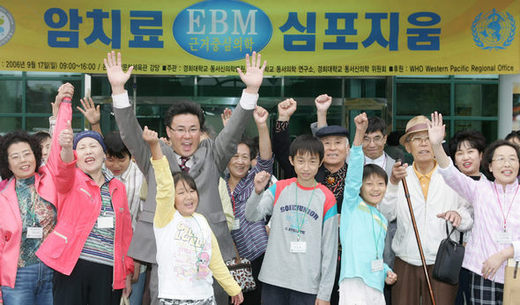 |
|
Choi Won-cheol, head of Kyung Hee University's cancer center, raises his hands with cancer survivors in attendance at a symposium held in Seoul on September 17.
|
Scientists hope five-year survival rates reflect breakthrough
The five-year survival rate of terminally ill cancer patients treated with an extract from the lacquer tree was between 22.4 and 25.9 percent. This figure stands in contrast to the fact that more than 90 percent of terminally ill cancer patients die within six months of diagnosis. The five-year survival rate of leukemia patients when treated with the extract was 73.1 percent, and such treatment proved most helpful for less terminally ill cancer patients - their five-year survival rate stood at 79.2 percent. By comparison, in the U.S. the five-year leukemia survival rate is 46 percent and the overall cancer survival rate stands at 64 percent. The findings represent one of the first times in the world that cancer has been sucessfully treated with natural medicine instead of surgery, radiation treatment, and/or pharmaceuticals. Hanyang University chair and professor Lee Yeong-jak said on Sept. 17, "The results were based on clinical research done on 216 cancer patients between March 1997 and May 2001 after treating them with an extract from the lacquer tree called ’Nexia.’ " The research was conducted by Choi Won-cheol, chief of the cancer center at Kyung Hee University East-West Medical Science Hospital.The results were publicized at a symposium in Seoul attended by some 300 cancer survivors, patients, and their families. The symposium was organized by the East-West Medicine Science Hospital and sponsored by the World Health Organization’s western Pacific office. As of March 2005, the survival rate of the 216 patients treated with Nexia was 44.9 percent. In the case of ‘solid form’ cancers, such as stomach and liver cancer, there were three survivors still in the "first stage" of cancer, 14 in the second stage, 35 in the third stage, and 85 in the fourth stage, or terminally ill. The remaining patients included 42 with leukemia and 37 with other forms of cancer. Of 85 terminally ill cancer patients treated with Nexia, 19 survived and three were unaccounted for, making the five-year survival rate between 22.4 and 25.9 percent. Of the surviving patients with terminal cancer, six have digestive cancer, five have ovarian, breast, or cervical cancer, five have rare cancers, four have respiratory cancer, and two have urogenital cancer. Of the 35 third-stage cancer patients, 28 have survived with the treatment of Nexia. Of those surviving, 13 have digestive cancer and six have ovarian, breast, or cervical cancer. In the case of leukemia patients, those who survived were six out of eight with acute myeloid leukemia, 14 out of 19 with acute lymphocytic leukemia, and eight out of 11 with lymphoma.





